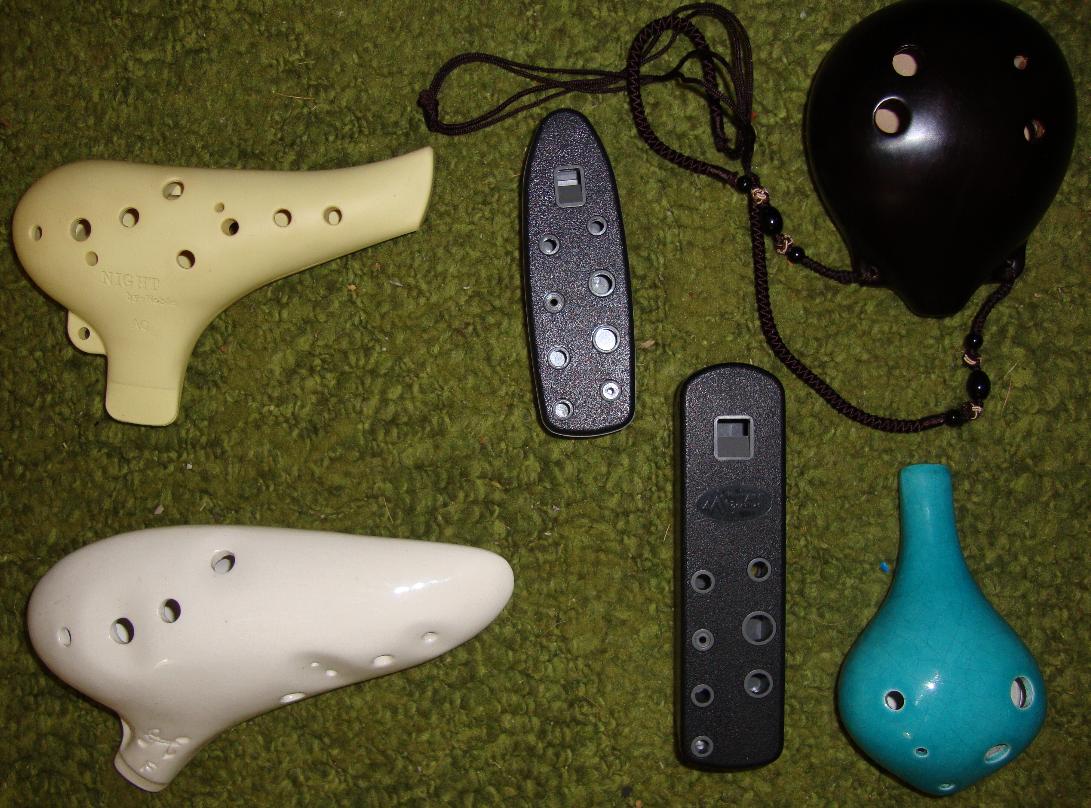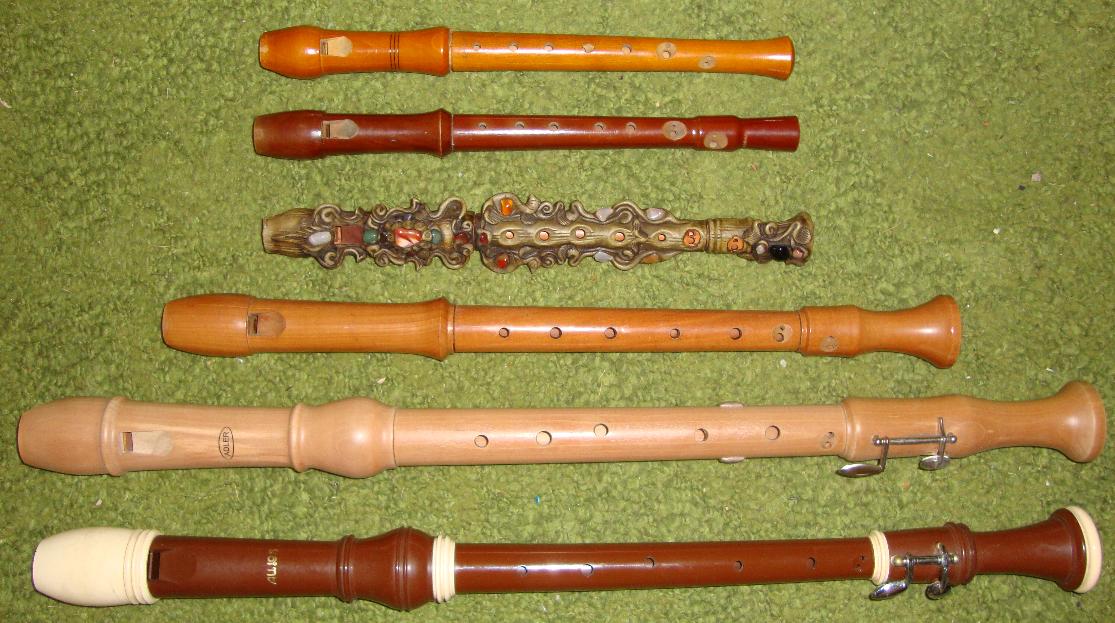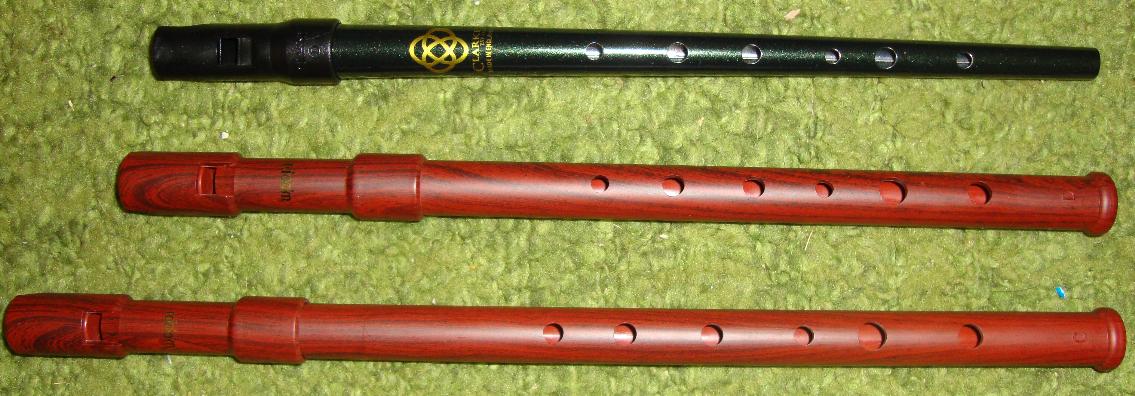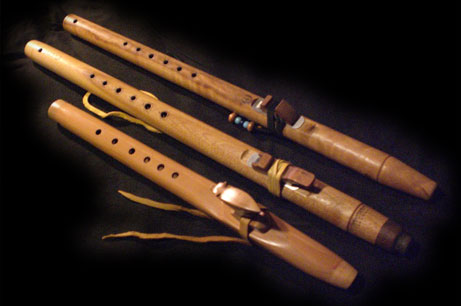Ocarinas, Recorders, Tin Whistles, and Native American Flutes
My previous article discussed inexpensive plastic flutes: tonettes, song flutes, flutophones, and precorders. Those pre-band instruments are ideal for introducing children to music. They're incredibly easy to learn and to play. What makes them interesting is that they've also become popular folk instruments. So many Americans grew up playing them in school — and so many millions more have been sold — that they've become a legitimate means of musical expression. Limited they may be, yet millions enjoy playing them.
Today we'll look at four other folk flutes: ocarinas, recorders, tin whistles, and Native American flutes. We'll answer basic questions about each. Which are easiest to learn? Appropriate for which kinds of music? Least inexpensive? What are their benefits and drawbacks?
All these flutes are fipple flutes — you blow into a mouthpiece that directs your breath to make sound. That makes them much easier to get started with than concert flutes or bamboo flutes. Beginners with those flutes spend days blowing into the mouthpiece to learn how to articulate notes.
Folk flutes are simple to learn, inexpensive, portable. There are tons of how-to videos and free sheet music for them on the web. They make excellent teaching tools for kids. And they're ideal for adults new to music. If you already play the concert flute, they'll open up a whole new world of creativity for you.
Let's take a close look at ocarinas, recorders, tin whistles, and Native American flutes. I'll include sound samples and links to free resources.
Ocarinas
Ocarinas are vessel flutes: flutes that voice based on the resonance of sound waves within a closed air chamber. They do not have open-ended bores as do recorders, tin whistles, and Native American flutes. This gives them their unique “full” sound.
Ocarinas date back thousands of years to the ancient Chinese and Mesoamerican civilizations. Italian Giuseppe Donati invented the modern oc in the 1850s. He standardized the instrument so that it could play western scales with simple fingering.
Ocarinas are typically made of clay, plastic, or sometimes wood. They come in many shapes but categorize into three: transverse, inline, and pendant. The photo below shows two transverse oc's on the left, two rectangular inlines in the middle, and two round pendants on the right.

Because of their shape, transverse oc's are sometimes called sweet potatoes or submarines. You play them sideways, like a metal concert flute. Put your mouth on the extended fipple and blow while placing your fingers over the holes. The instruments typically have 8 to 10 fingering holes on top, and two thumb holes underneath. The more fingering holes, the more notes you can play. For example, the smaller oc in the upper lefthand corner plays from A4 to F6 plus all intervening sharps and flats. (Middle C on the piano is C4). That's a range of 13 whole notes — certainly enough to play any song you like.
The yellow plastic transverse in the photo is the most popular size of ocarina — the Alto C. Other sizes include the smaller soprano, larger tenor, and the still larger bass. The bigger the oc, the lower it sounds. And the softer its voice. Small oc's can be pretty loud, so sometimes people buy larger ones so as not to disturb others. Bigger oc's cost more, of course.
You finger transverse and inline oc's in the same way. The main difference with inlines is their shape and that they extend straight out from your mouth when you play them. (As folk instruments, different brands of ocarinas sometimes have very minor fingering differences.)
The two pendants in the photo have only 4 holes on top plus two thumb holes beneath. (Some pendants don't even have the two thumb holes.) Pendants have an entirely different fingering system than the transverse/inline system. They're called pendants because most have attached necklaces so that you can wear them around your neck, like the black oc in the photo. Pendants are also called seedpods.
Beware of pendants that aren't playable. There's a whole universe of decorative oc's — many from Latin America — that make dandy keepsakes but are not playable instruments. You can spot them because all their top holes are the same size. A playable seedpod requires differently-sized finger holes.
Which oc's are easiest to learn? Transverse/inline fingering is more intuitive. You progressively raise your fingers off the holes to ascend the scale, just like you do with recorders, tin whistles, and Native American flutes. These oc's can play all sharps and flats but that requires cross-fingering.
Most oc players start with a transverse Alto C. Plastic is more durable and less expensive, though some favor the more subtle tones of ceramic. Plastic or ceramic, oc's start at $10. Excellent ones cost only $20 to $40. Be sure to read reviews before you buy. Listen to a sound sample, too. Some oc's are not well tuned: remember, these are folk instruments. My own recommendations appear in the table at the end of this article.
Let's listen to some ocarinas. To get you in the mood, here's an inspiring piece by a professional. (The musician plays a multichamber oc, an ocarina with more than one air chamber that enables a greater pitch range than normal single-chamber oc's. It's tough for beginners, unfortunately.) A better bet is the transverse Alto C I mentioned earlier.
Here's a demo of the very popular plastic Focalink Alto C that retails for about $27, and here's a review of a ceramic alto C from OcarinaWind that goes for $23. Focalink and OcarinaWind products both boast excellent Amazon ratings.
So why is the ocarina considered a folk rather than a concert instrument? Its pitch range is limited compared to orchestral instruments that span 2 1/2 to 3 octaves. And you can't tune the oc to fit it in better when playing with others.
The good news is that ocarinas are incredibly easy to learn. Even beginners can produce their captivating sound. You can get started for only $25 or $30. Everything beyond the oc itself — lessons, tutorials, sheet music, and more — is free on the internet. If you've never played an instrument before or just love their exquisite voice, try an oc.
Ocarina – Free Resources
- Youtube channels: David Erick Ramos, Kissing88, STL Ocarina
- Product reviews: The Ocarina Network's online forum, Ocarina reviews at Amazon, Ocarina reviews on Youtube
- Community: The Ocarina Network's Facebook group, The Reddit ocarina community
- Free sheet music: 12HoleOcarina.com, Pinterest posts, STLOcarina, OcarinaSongbook, OcarinaTabs
Recorders
Recorders are end-blown flutes that trace their ancestry back to medieval Europe. When classical composers wrote for “flute” before the 19th century, they were often referring to what we today call the recorder. The modern metal concert flute wasn't perfected until the 1800s.
Like ocarinas, recorders feature simple fingering for whole notes. Among their several fingering systems, the most popular is called baroque or English fingering.
Recorders come in standard sizes like sopranino, soprano, alto, tenor, and bass. As with ocarinas, the bigger instruments are both lower-pitched and quieter. This presents an advantage if loudness is a concern where you play. Bigger also means more expensive. The tenor in a company's line will cost more than its alto and much more than its soprano.

New players typically start with the ubiquitous soprano. Its pitch ranges over two octaves, from C5 to D7. ABS resin plastic is an excellent choice for a first instrument. It's inexpensive and sounds great, yet it's durable and easy to take care of. I recommend quality plastic sopranos like those from Yamaha and Aulos. They check in at only $20 to $30.
Many players start with a good plastic soprano, then as they acquire skills, they add a wood soprano or an alto. The lower alto voice is particularly haunting. This Youtube video can help you choose a good beginner soprano.
Wood is the traditional material for recorders. It's more expensive, with prices ranging from $30 to $90 on the low end, up to hundreds for the mid-range, and thousands for the top instruments. The less expensive ones are factory produced from woods like pearwood or maple. Craftsman create the more expensive ones from specialty woods. Keep in mind that price alone doesn't determine quality. Sound is subjective and personal taste differs. Some say the skill of the player counts more than the quality of instrument.
This Youtube video tells what to look for in buying a new recorder. As with ocarinas, quality varies enormously. I recommend listening to a sound clip either at the manufacturer's website or Youtube before buying. Read all the reviews you can, too.
In contrast to ocarinas and Native American flutes, recorders are tunable. Most consist of either two or three pieces. You tune the instrument by moving the mouthpiece in or out. This is a big advantage in group playing. Along with all the available music, it makes the recorder the superior choice for duets, trios, and quartets.
Let's listen to a few sound samples. In case you've never heard a recorder ensemble, here's a quintet playing Greensleeves. This performer demonstrates the soprano on several classical pieces. That's a $45 plastic instrument he's using so don't let anyone convince you to spend hundreds on an expensive wood recorder until you're ready. Here's how that sweet alto I mentioned sounds.
With its tunability and two-octave range, the recorder offers ensemble fun and musical possibilities beyond those of many other folk instruments.
Recorder – Free Resources
- Youtube channels: Sarah Jeffery, You Can Play It
- Product reviews: Sarah Jeffery's recorder reviews, Recorder reviews at Amazon, Recorder reviews at Youtube
- Community: American Recorder Society (website), American Recorder Society (Facebook), Reddit recorder community, A Facebook Recorder group
- Free sheet music: 8Notes, Sheet music at Pinterest, Free-Scores.com, The Solo Recorder, Virtual Sheet Music
Tin Whistle
Tin whistles are also called penny whistles or Irish whistles. Like ocarinas and recorders, they trace their heritage back to the earliest civilizations. The modern whistle is a much more recent invention. Only in the 19th century did it standardize in its present form.
The instrument's forte is traditional Irish, Scottish, and Celtic music. Yet it's versatile enough to play American folk music or any other genre you wish.

Penny whistles come in many different keys. The D whistle is most common. These measure a bit less than a foot long and are surprisingly lightweight. The above photo shows two D whistles and a slightly longer C whistle below them. As with ocarinas and recorders, larger instruments have lower pitches.
One of the delights of whistling is the variety of instruments available. Some pipes have tapered bores while others are straight. They're made from all sorts of metals: brass, nickel, nickel-plated brass, tin, aluminum, even lead (back before they learned it wasn't safe). Other materials include ABS resin plastic, wood... and even home-mades from PVC pipe!
The body of the instrument combines with a fipple, or mouthpiece. These can be plastic, wood, or metal; and either separate or built-in. Only whistles with separate fipples are tunable.
Add it all up and you have a gloriously varied universe of whistles to explore. Based on different design and materials, some whistles sound bright and clear; others, musky or rustic; and still others, soft and warm. Whatever your taste, there's a whistle to match it. Part of the fun of whistling is finding your favorite pipe. With whistles being so inexpensive, many players build collections.
Penny whistles finger like transverse ocarinas and recorders in that you progressively lift fingers to hit higher notes. But the similarities end there. Whistles have only six top holes and no thumb holes beneath. With a pitch range of about two octaves, you achieve the higher octave by overblowing the instrument. You finger the higher octave the same as the lower, and hit the higher notes by blowing harder. This is an entirely different concept than instruments like the recorder where you finger the “octave hole” with your thumb to move up an octave. Overblowing might sound difficult at first, but it doesn't take much practice to learn.
Like alto C ocarinas, high notes on the D whistle can be loud — they might disturb close neighbors. Experienced players learn to clearly articulate high notes with a nice tone.
With its two-octave range, the whistle lets you play any kind of music. It can play all sharps and flats, yet most consider the whistle a diatonic instrument. Why? Those sharps and flats involve not only cross-fingering but a lot of half-holing. This requires some practice, especially with fast tunes. A simpler approach is to to switch keys simply by playing a different whistle. Or, change the key of the tune to fit your whistle.
The popular D whistle sounds D5 as its base note. (That's one note above the C5 base note of alto C ocarinas and soprano recorders.) It's a fairly high-pitched instrument. D whistles pop out quick-fingered notes in a bright, dynamic way that makes them ideal for quick dance tunes, happy jigs, and the like. Ornamentation shows off well. Many players enjoy learning fancy techniques for Celtic music. But those aren't necessary unless they interest you.
Which whistle should you start with? Yikes, you'll get a ton of advice on this topic! Just like ocarina and recorder players, everyone promotes their favorite. Here's a secret. I only started playing the whistle last year, having never touched one before. I tested a flock of whistles and found I could immediately hit all the notes with the Clarke Sweetone. I don't know that it's the best whistle ever made but it's surely a great one to start with. It's got a pleasing tone, too. All for only about $15. You can't lose with it.
Let's listen to sound samples. How about the dramatic theme from the film Titanic? Celine Dion's signature hit includes several penny whistle solos. This clip features the whistle in a song by the neoceltic folk band OMNIA. Here's a comparative review that demos sound samples from several whistles you might consider buying, and this video reviews several more.
If you have an interest in Celtic culture, or you'd just like an inexpensive start with an incredibly expressive instrument, the penny whistle might be for you. You can see if it suits you for only $15.
Tin Whistle – Free Resources
- Youtube channels: CutiePie (aka Stephanie), Online Academy of Irish Music
- Beginner tips: The Whistle Shop
- Product reviews: Celtic Music Archives, Whistle reviews at Youtube, Whistle reviews at Amazon
- Community: Chiff and Fipple forum, Reddit Group, Tin Whistles on Facebook
- Free sheet music: Irish-Folk-Songs.com, Whistle Tabs, Tin Whistler, 8Notes
Native American Flute
Historically, Native Americans comprised a diversity of related peoples with different languages and cultures spread over a vast geographic area. They invented many kinds of flutes and developed varieties of each. The Native American flute gives you access to this unique musical tradition.
What we call the Native American flute today is the result of a standardization process that occurred in the 1980s. This evolution brought Native American flutes closer to conformance with European musical concepts. For example, base pitches were standardized and the pentatonic minor scale, a five note scale, became predominant. The result has been an explosion of interest in Native American flutes.

As you can see, the flute is defined as having an external block held in place on top by a strap. You blow into a breath hole that connects to a small air chamber preceding the block. Your breath hits a splitting edge behind the block at the start of the larger sound chamber. The sound chamber has either five or six top holes you finger to alter the pitch. (The instrument has no thumb holes.)
Like tin whistles, Native American flutes are primarily considered diatonic instruments. Fingering whole notes is simple. Just progressively lift your fingers for higher notes. Sharps and flats are possible, too, but fingering varies across flutes.
Similar to tin whistles, these flutes are crafted in every imaginable key. G is most popular. Many people are attracted to the sounds of even lower-pitched flutes, but not everyone can reach their key holes. So if you want to buy an F#, F, or lower flute, make sure you can comfortably reach all the holes first.
One other fact: six holes are better than five because they yield more notes. So most experts advise beginners to start with a six-holed flute in A, G, F# or maybe F. Listen to these sound samples to determine which pitch appeals to you. Of course, you'll also want to listen to any specific flute before you buy it.
Native American flutes are typically produced from woods like cedar, walnut, juniper, redwood, cherry or other more exotic choices. As with recorders, wood density affects tone (though not so much, perhaps, as the flute's design parameters). Coloring often depends on staining techniques more than the wood used. Given that the instruments are handmade, prices reflect labor costs. As with wood recorders, many cost several hundred dollars. However, there are excellent flutes available for under $100 if you seek them out, as my recommendations show.
Plastic is an option, too. Plastic flutes may not have the authenticity of handcrafted wood ones, but they're durable and can voice well.
Most Native American flutes are keyed to the pentatonic minor scale. This lends them their soulful, contemplative sound. Advanced players can play other scales, too. The range of the instrument varies from 1 to 1 1/3 octaves. With some flutes you attain the highest couple notes by overblowing (just as with the tin whistle).
Native American flute music is pure and relaxing. It attracts tens of millions of listeners at Youtube. Listen to this example or this one. Wow.
You might enjoy joining a flute circle. These groups let you to socialize with other flute players, sharing and learning together. Search this list and this one for a circle near you.
Its five-note scale makes the Native American flute incredibly easy to play. All notes sound pleasing together, so you simply can't hit a wrong one. That's the big draw to this instrument. Whether or not you have musical training, you can express yourself with a Native American flute.
Native American Flute – Free Resources
- Beginner tips: Flute Tree Foundation, Ancient Territories
- Encyclopedia: Flutopedia
- Community: Facebook Native American Flute group, Facebook NAFlute group, Another Facebook NAF group
- Free sheet music: Flutopedia, Pinterest posts, Flutetree
Conclusion
How do our four kinds of flutes compare? All are easy to learn. Yet the Native American flute stands out in this regard, with its simple pentatonic scale and limited fingering. This is truly an instrument anyone can play.
Ocarinas follow close on. If you can blow, you can elicit their soulful tones. Their limited pitch range means you need learn few fingerings.
Tin whistles and recorders are easy for beginners to start with, too. But they require greater effort if you wish to explore all their possibilities. Some whistlers progress into fast-fingered ornamentation and chromatics while some recorder players take on ambitious classical music.
In the end, the old saw applies to each of these folk flutes: It's easy to learn but takes a lifetime to master.
You can get started with any these folk flutes for only $20 or $30. Native American flutes are the exception, with their entry price of $70 to $100. All other resources for these instruments are free on the web — tutorials, sheet music, how-to's, peer advice, instructional videos, and more.
So what are waiting for? Grab a folk flute and begin your musical journey!
Summary Chart
| Transverse Ocarinas | Recorders | Tin Whistles | Native American Flutes | |
|---|---|---|---|---|
| Range | Varies, most 10 to 13 notes* | About two octaves | About two octaves | Pentatonic; 1 to 1 1/3 octaves |
| Holes on top | 8 to 10 | 7** | 6 | 5 or 6 |
| Thumb holes | 2 | 1 | 0 | 0 |
| Price | $10 on up | $10 on up | $10 on up | $80 on up |
| Common materials | plastic, clay (wood) | plastic, wood | various metals (plastic, wood) | wood (plastic) |
| Tunable | no | yes | varies | no |
| Sharps and flats | yes | yes | usually considered diatonic but yes with half-holing | usually considered diatonic but most chromatics are possible*** |
| Overblowing? | no | no | yes | on some flutes for a few high notes |
| Exceptional for | popular tunes, folk music | Baroque music | Irish, Scottish, Celtic music | Native American music |
** Double holes count as one.
*** See this discussion on scales and tuning.
My Recommendations
Here are popular, inexpensive flutes for beginners. They're easy to start with and produce great sound. (Disclaimer: I receive no compensation for these recommendations.)
| Transverse Ocarinas | Recorders | Tin Whistles | Native American Flutes | |
|---|---|---|---|---|
| Plastic | Alto C – Focalink or Night by Noble | Soprano – Yamaha YRS-314B or 402B or Aulos 507B or 503B | Woodi in D and C or Dixon D Tunable* | Northern Spirit Flutes |
| Ceramic | Alto C – OcarinaWind has a great selection | – | – | – |
| Metal | – | – | Clarke Sweetone in D | – |
| Wood | Hind | Soprano – Coolsma good at $50–$75, Mollenhauer several $30–$90 | – | Laughing Crow or Gray Fox Flutes or Blue Bear Flutes or Stellar Flutes |
About the Author
Howard Fosdick is a computer scientist who plays a variety of woodwinds. He researched and wrote this article when he discovered the paucity of information comparing folk flutes on the web. You might be interested in his companion article that contrasts tonettes, song flutes, flutophones, and precorders.